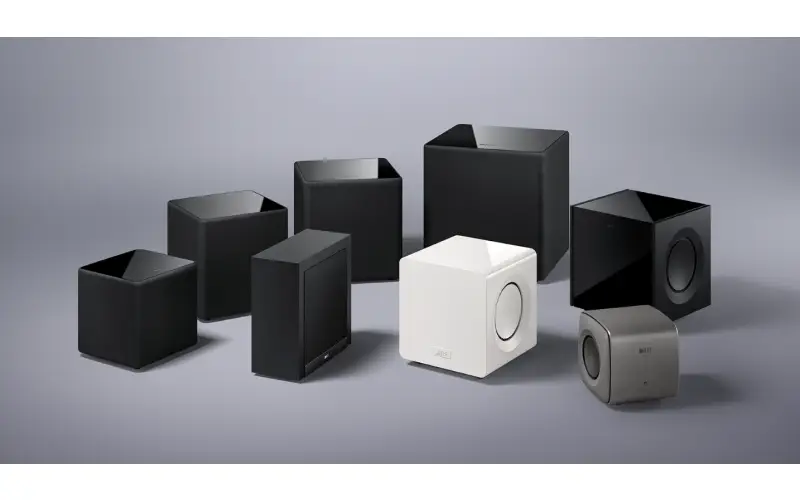By: CE Critic
As a home theater enthusiast, you know that impactful bass response is crucial to an immersive cinematic experience. But in a small room, achieving that perfect low-end rumble can be tricky. Fear not! This article will dive into advanced techniques for optimal subwoofer performance. We'll dispel myths, provide expert guidance, and explore the surprising advantages of using multiple subwoofers even in restricted spaces.
Why Small Rooms Pose Unique Challenges
Small rooms have inherent acoustic quirks, particularly with bass frequencies:
- Standing Waves: Sound waves reflect off walls. In small rooms, these reflections interact with the original sound, creating peaks (loud spots) and nulls (quiet spots) at different frequencies. This leads to uneven, boomy, or muddy bass.
- Limited Placement Options: Small room layouts often constrain subwoofer placement, making it harder to find a spot that delivers balanced low-frequency sound.
1. The Subwoofer Crawl: Placement is Paramount
Before tweaking settings, placement is key. Try the 'subwoofer crawl':
- Temporarily put your subwoofer at your main listening position (where you sit).
- Play bass-heavy content (music or movies).
- Crawl around on the floor where you'd consider placing the sub.
- Notice where the bass sounds smoothest and most even. That's the ideal spot!
This seemingly bizarre method reveals where your room's acoustics work best for bass reproduction.
2. Dialing It Down: Matching Levels
Often, small rooms call for subwoofers turned quieter than you'd think. Follow these steps:
- Calibration Tools: Use your receiver's built-in calibration (like Audyssey) or an SPL meter (sound pressure level meter) to set the subwoofer's volume in relation to your other speakers.
- Fine-Tuning by Ear: Rely on your ears, too! If the bass dominates even after calibration, adjust the subwoofer's level down slightly until it blends seamlessly.
3. Phase Alignment: Timing Matters
The subwoofer's output needs to be in 'phase' with your main speakers for optimal integration:
- Phase Switch: Many subwoofers have a 0/180 degree phase switch – experiment!
- Continuous Control: Some receivers offer finer subwoofer phase adjustment. If yours does, take advantage of this for the most precise alignment.
4. Low Pass Filter: Setting Boundaries
Your subwoofer and main speakers shouldn't overlap too much in the frequencies they play:
- Receiver Crossover: Set your receiver's crossover slightly higher than your speakers' rated low-frequency point. Example: Speakers good down to 60Hz = set crossover at 80Hz.
- Subwoofer Crossover: Usually, the subwoofer's own low pass filter can be bypassed if your receiver handles the crossover. Otherwise, ensure their settings match.
5. EQ to the Rescue: Room Correction
Room correction software tackles the uneven frequency response caused by your room's acoustics:
- Built-in Tech: Many modern receivers offer Audyssey, Dirac Live, or other room correction systems. Run these calibration processes carefully!
- Advanced EQ: Higher-end subwoofers sometimes include their own EQ systems or even dedicated smartphone apps for precise adjustments.
6. Breaking the Mold: Multiple Subwoofers
Here's where things get exciting. It may seem counterintuitive, but using multiple subwoofers in a small room can yield huge benefits:
- Smoothing the Response: Multiple subs strategically placed around the room help cancel out peaks and nulls, leading to more even bass throughout.
- Reducing Localization: One subwoofer can sound too easy to locate (giving away its position). Multiple subs make the bass seem to be coming from everywhere, enhancing immersion.
- Lower Required Output: Rather than blasting a single sub, two or more can share the workload, reducing distortion and improving overall sound quality.
7. Beyond the Basics: Advanced Techniques
If you're truly committed, consider these pro-level solutions:
- Bass Traps: Acoustic panels designed to absorb low frequencies can further tame boomy spots in your room, complementing good subwoofer placement and EQ techniques.
- DSP (Digital Signal Processing): Powerful DSP platforms offer incredibly granular control over a subwoofer's output, from customized EQ curves to managing multiple subs and correcting for time delays. Popular options include MiniDSP and custom software solutions.
- Tactile Transducers: Also called "bass shakers," these devices attach to your chair or couch, translating bass frequencies into vibrations you physically feel. This adds an extra dimension to movies and games, especially beneficial in a small room where you may not be able to crank up the subwoofer.
Implementing Multiple Subwoofers: A Quick Guide
Now that you understand the concept of using multiple subs, here's a basic approach to get you started:
- Similar Subs: Ideally, use identical or very similar subwoofers to ensure consistent output and behavior.
- Placement Strategy: Instead of bunching subs together, spread them out. A common starting point is putting one near the front of the room and one near the back, on opposite walls if possible.
- Careful Calibration: If your receiver allows independent calibration of multiple subs, take full advantage of it! Manually aligning levels, phase, and distance (if available) is crucial. For even more precise control, consider DSP solutions that focus on multi-sub optimization.
Caveats and Considerations
While the benefits of multiple subwoofers are substantial, there are some important points to remember:
- Cost: Naturally, deploying multiple subs will increase your overall budget.
- Space: Even in a small room, you'll need to find suitable locations for each subwoofer.
- Complexity: Setup, calibration, and integration become more complex with additional subs. Be prepared to experiment and learn about advanced room correction techniques.
Is it Worth It?
Deciding whether to implement advanced techniques or use multiple subwoofers is entirely subjective. Consider these factors:
- Room Size and Severity of Issues: If your room is very small or acoustically troublesome, advanced solutions and multiple subs may offer profound improvement.
- Budget: These upgrades can range from moderately affordable (bass traps, DIY DSP) to costly (multiple high-end subwoofers).
- Dedication: Are you willing to invest time in proper placement, calibration, and tinkering? The potential payoff is immense, but it requires effort.
Final Advice: Listen and Experiment!
The world of audio is as much about the art as it is about the science. There are no unbreakable rules! Always rely on your critical listening skills to determine what sounds best to you. Don't be afraid to experiment with non-traditional placement, subwoofer settings, and advanced technologies to unlock the full potential of your home theater in that cozy small room.





